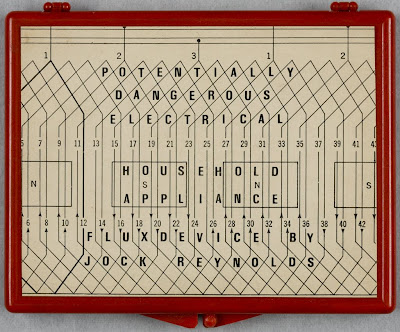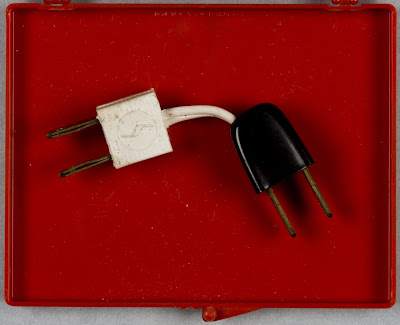Jock Reynolds
Potentially Dangerous Electrical Household Appliance
New York City, USA: Fluxus, 1969
Hinged plastic box, electrical cord with two plug ends, textured optical plastic
9 x 12 x 1.6 cm
Edition size unknown
Above: a prototype and the eventual edition, both with labels designed by George Maciunas.
Below: an excerpt from an interview with The Brooklyn Rail, from May of this year.
Rail: I’ve looked at a few works you made in 1969 (your senior year). For example, there’s a hinged plastic box with a vinyl border, an electric cord with two plugs, and a toothbrush with real teeth inside it. They look like Fluxus objects!
Reynolds: They were. [Gurdon] Woods did an amazing thing in 1967, in that he applied to the Carnegie Foundation and received a very large grant to experiment with undergraduate education and art. This grant enabled him to invite a whole group of amazing artists to the campus throughout the 1968–69 academic year. I remember there were 16 of us students—we didn’t know what we were being recruited for—who were asked to sign up for a year-long experimental interdisciplinary art workshop. We did so, and its leader was the Fluxus artist Robert Watts. He, along with Woods, were instrumental in inviting George Maciunas, John Cage, Merce Cunningham, Allan Kaprow, Dan Flavin, George Segal, James Lee Byars, and others to campus; the list goes on. Some of these visiting artists would come for a few days to do a performance or to show films by the likes of Andy Warhol. Other artists stayed longer to conduct mini-seminars in which they shared their work and provided critiques to the work we students were making both individually and as a creative collective. We staged a number of Fluxus-like performances, including a hilarious Fluxus parade on the campus of U.C. San Diego in the last semester of our work with Watts. These events were often very humorous, and sometimes quite mischievous, but also always creatively purposeful and well nurtured by those who taught us. I remember Maciunas brought one of his Flux briefcases out west with him and showed us what was inside: 17 boxed objects from 17 Fluxus artists, including Yoko Ono’s infamous film “Bottoms (No. 4)” and a Stan Van Der Beek film loop, among other visual oddities that fascinated us. He invited us to join him and make similar things, so I started to make a series of objects I felt were in the spirit of Fluxus and sent them off to George over the next few years, having no idea that he was actually going to produce and distribute them! Happily, I started receiving Fluxus mailings from artists residing all over the world, which was an unexpected bonus that arose from Watts’s workshop.




nice info
ReplyDeletehttp://mypowerandelectric.blogspot.com/2014/02/iron-man.html